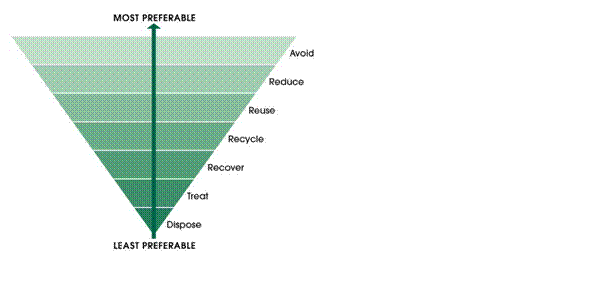
The EPA regulates the management of solid and liquid waste in South Australia, including the transport, handling, storage, treatment (including recycling and recovery) and disposal of waste, as well as activities that produce certain types of waste.
Through its compliance efforts and reform processes, the EPA is committed to establishing the right regulatory settings to support the sustainable operation of the waste and resource recovery industry by seeking to:
- minimise the risk of environmental harm occurring,
- support the highest and best, safe available use of secondary materials in accordance with the waste management hierarchy,
- provide more certainty and fairness for lawful operators, promoting investment, innovation and growth of the sector,
- stamp out illegal operators, and
- obtain levy revenue due to the South Australian Government.
We also administer South Australia’s highly successful container deposit legislation, which has significantly reduced litter in our state.
Strategy
The Environment Protection (Waste to Resources) Policy 2010 (Waste to Resources EPP) seeks to achieve sustainable waste management by applying the waste management hierarchy consistently with the principles of ecologically sustainable development.
Complementing the Waste to Resources EPP, South Australia’s Waste Strategy 2015–2020 has as its mission, ‘To achieve a resource efficient South Australia, by minimising South Australia’s demand on primary resources, and maximising the reuse, recycling and recovery of materials, using the framework of the waste management hierarchy and the principles of ecologically sustainable development’.
The strategy is part of the framework of policies, strategies and plans that link Australian, state and local government and other organisations. These linkages are outlined in the strategy.

Regulation
The EPA regulates the waste and resource recovery using the powers and tools established under the Environment Protection Act 1993 (the Act), including the Environment Protection Regulations 2009 and the Environment Protection (Waste to Resources) Policy 2010 (Waste to Resources EPP). In addition, the EPA has specific powers in relation to conditions of approval for activities that require approval under the Development Act 1993.
- Notable features of the Act for the waste and resource recovery industry
- Key features of the Waste to Resources EPP
Other relevant state legislation includes the Local Nuisance & Litter Control Act 2016.
In addition, the EPA relies on and honours relevant national and international laws and environmental agreements.
Waste reform
The South Australian Government is seeking to help realise the economic potential from innovation in waste and resource recovery technologies, while at the same time protecting the environment.
The EPA is pursuing a suite of legislative and administrative waste reforms to provide the right regulatory settings to support the sustainable operation of the sector.
Licensing requirements
Schedule 1 of the Environment Protection Act 1993 sets out prescribed activities of environmental significance that require licensing. Clause 3 of schedule 1 particularly sets out the waste management activities, including the transport of waste, that require a licence. In addition, clause 2(11) specifies when scrap metal recovery requires licensing and clause 6(3) provides composting works requirements.
Information on licensing, including how to apply for a licence, is available in the Business and Industry section.
Waste levy
Section 113 of the Environment Protection Act 1993 requires the payment of prescribed levy by the holder of a licence to conduct a waste depot in respect of waste received at the depot. Regulation 70 of the Environment Protection Regulations 2009 prescribes the waste levy payable. Information on measuring and reporting requirements are set out in the Waste Levy Guidelines.
Waste levy rates 2018–19
What is waste
The Environment Protection Act 1993 (the Act) defines waste as:
- any discarded, rejected, abandoned, unwanted or surplus matter, whether or not intended for sale or for recycling, reprocessing, recovery or purification by a separate operation from that which produced the matter; or
- anything declared by regulation or by an environment protection policy to be a waste;
whether of value or not.
The EPA’s Waste definitions guideline reflects the above definition and includes a range of definitions of specific wastes and waste-related terminology.
The status of a material as a waste (which includes by-products or leftover surplus materials) is determined at its place of generation and is not dependent on:
- it being wanted
- it being intended or capable of being reused, recycled or recovered
- it having value or able to be sold or traded
- the recipient asserting that it is a resource.
When is waste no longer regulated as waste?
To achieve a more sustainable environment, there is real value in diverting suitable waste for resource recovery, through activities such as recycling.
Under the Waste to Resources EPP, a waste, or material resulting from the treatment of waste, may cease to be a waste when:
- it constitutes a product that meets EPA specifications or standards; or
- if there is no specification or standard applies, it constitutes a product that is ready and intended for imminent use without the need for further treatment to prevent any environmental harm.
Ready and intended for imminent use means that, upon request, you can demonstrate to the EPA, among other things, that:
- there is an immediate market for the recovered material; and
- the recovered material and its use complies with all relevant state and federal legislation including regulations and policies made under relevant laws, Australian Standards and any specifications required by the market place eg engineering specifications; and
- where relevant, the waste has undergone a physical or chemical process, such as an operation to recycle, reprocess, recover or purify it, and/or, sampling and testing of the physical and chemical characteristics of the material has been undertaken by a suitably qualified person, the results of which demonstrate:
- that environmental harm, including harm to human health, will not result from the storage, transport and use of the recovered material, and
- that the recovered material is suitable for its intended use.
More detail on the EPA’s expectations for recovered materials is available at 2007–10 Waste Management Reform project.
Standards and specifications
Managing waste types
Transporting waste
The collection or transport of waste for fee or reward may require a licence (see Licensing Requirements above).
Whether or not a licence is required, all transporters of waste must comply with the general waste transport requirements of the Waste to Resources EPP
In addition, the transport of particular wastes that may pose a high risk to the environment are tracked, using WasteTracker.
